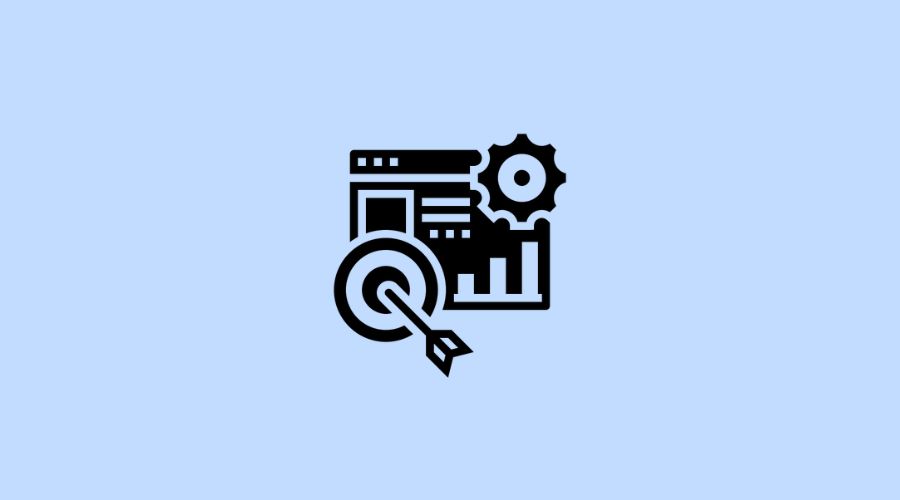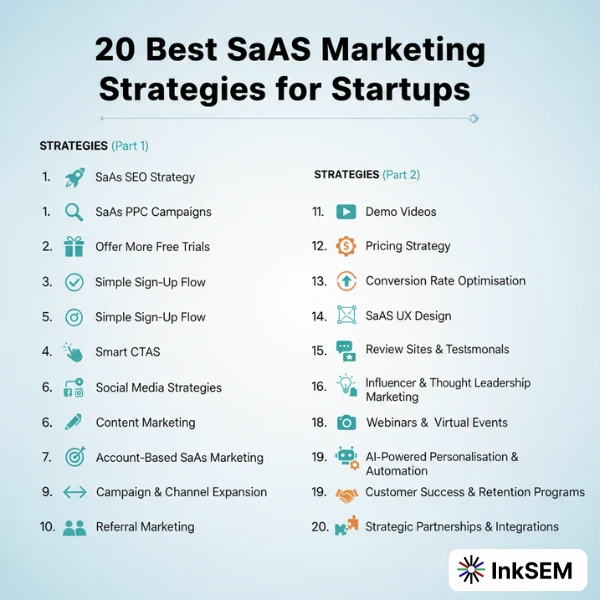20 Cost-Effective SaaS Marketing Strategies for Early-Stage Startups

Early-stage startups have a long and complicated path to growth and profitable customers. In a competitive market with limited funds, selecting the right SaaS marketing strategies becomes crucial to differentiate oneself from competitors. By concentrating on cost-effective ways to achieve this, a startup will maximize its resources, whether it’s in SEO, social media, customer retention, or partnerships. A smart strategy makes the difference.
In this post, we’ll cover the 20 best SaaS marketing strategies for startups, as well as touch on what it looks like to develop a SaaS marketing plan and how you can manage your SaaS Startup marketing budget most effectively.
SaaS Startup Marketing Budget: How to Plan for Growth
Budgeting wisely is key for early-stage companies. Startups differ from existing companies in that they operate with fewer resources. Distributed funds across channels drive winning performance and long-term success.
Begin by understanding the cost of acquiring customers. See where competitors are spending and consider which channels offer the most ROI.
20 Best SaaS Marketing Strategies for Startups
Here are 20 powerful and affordable SaaS marketing strategies that startups at the early stage of their life can use to scale growth faster with a minimal budget.

SaaS SEO Strategy
SEO is one of the long-lasting growth tactics. Creating SEO optimized content for specific keywords gives you exposure in organic search, which should bring your SaaS product long-term traffic at little cost. Invest in writing high-value blogs, landing pages, and case studies that match customer intent.
But don’t forget about technical SEO, which can further boost rankings: things like site speed, mobile optimization, and schema markup. Gradually, this will reduce the dependence on paid ads, and businesses will have a steady flow of incoming leads.
SaaS PPC Campaigns
Paid marketing can drive fast results if used properly. On platforms such as Google Ads and LinkedIn, there are targeted campaigns that reach the decision-makers. When you do, start small with your testing, fine-tune that messaging, and slowly scale so you don’t overspend.
Retargeting ads for returning visitors maintains the awareness and interest in your SaaS solution, enhancing your chances of getting sign-ups.
Offer More Free Trials
Free samples allow prospects to try your product free of any risk. You can attract leads who are hesitant to an upfront financial commitment by providing trial extensions or feature-limited versions as a “first hit”. Make sure the trial process showcases your product’s most popular features.
Including some in-app tutorials or guided tutorials to help users understand the value may lead them toward becoming paying customers.
Simple Sign-Up Flow
It can be frustrating to have a complex sign-up process. Keep it short and simple, request only what you need to know. The use of social login alternatives or single sign-on (SSO) will also aid in boosting conversion rates.
A/B test various versions of your sign-up page to eliminate obstacles. The smoother the process, the better the first impression and the likelihood of further trial.
Smart CTAs
A carefully designed call-to-action (CTA) strategy will point your prospects in the direction of the next action to take. Use convincing and context-aware CTAs, such as “Start Free Trial”, “Book a Demo”, or “Download Guide”. Test various models to maximize performance.
Strategically add CTAs to your website, blog, and even emails. The more organic and the better timed they are, the greater likelihood you’ll have of converting.
Social Media Strategies
It is also a lower-cost way of increasing brand awareness. Social Media platforms, such as LinkedIn, X (Twitter), and Instagram, are opportunity-rich environments where startups can showcase the best of their work (content), spark conversations (content with an emotive pull) with users, and build community.
Monitor discussions and trends with social listening tools. This is an insight into what your audience cares about and allows you to participate in discussions that are relevant.
Content Marketing
Great content establishes authority and informs potential customers. Blogs, case studies, eBooks, and tutorials can attract organic traffic whilst proving credibility. By including SaaS product marketing content, you can also emphasize what features make your solution unique.
Diversify types of content, combined with written guides, podcasts, infographics, and short-form videos, appealing to diverse audiences’ tastes.
Account-Based SaaS Marketing
For B2B SaaS, account-based marketing (ABM) works really well. Rather than broad targeting, concentrate on high-value accounts using customized campaigns. Better outreach means more conversions and stronger relationships.
ABM success requires teamwork between marketing and sales. Coordinate messaging and objectives so that every interaction with target accounts feels well-integrated and relevant.
Campaign & Channel Expansion
Use more than one channel. When you find what works, expand to other channels, such as podcasts, forums, or newsletters. By reusing content across different formats, you expand your reach without spending much more money.
It’s a way to expand the brand in more places and reach prospects where they are, since decision-makers don’t all necessarily spend their day on one platform or device.
Referral Marketing
Satisfied clients are your best advocates. Referral discounts incentivize customers to refer new users. Referrals can be mutually beneficial by creating programs such as discounts, credits, or premium features.
Allow users to share their referral links from the comfort of your SaaS. The more simplistic the process is, the more likely the end users are to put their weight behind it.
Demo Videos
Video marketing is one of the most engaging formats. Create quick, educational demos that demonstrate how your SaaS product can solve real-life issues. Promote them on your website, YouTube, and social platforms.
By incorporating clips of customer testimonials into demos, your credibility is better showcased, and prospects are more assured about the merits of your product. For companies offering custom SaaS development, detailed demo videos can effectively show the overall functionality and unique value proposition.
Pricing Strategy
Flexible pricing that attracts startups and small businesses has always been an effective strategy for new SaaS startups. You can provide tiered or pay-as-you-go options to catch the initial users. Clear pricing establishes confidence and removes obstacles to participation.
Experiment with different pricing models until you find the one that sticks best with your target market. A good plan can greatly increase your conversion rates.
Conversion Rate Optimization
CRO makes sure your traffic becomes paying customers. A/B test landing pages, CTAs, and onboarding to find drop-off points. Small improvements can translate to tidy increases in revenue.
User behavior patterns can be found by using heatmaps and A/B testing tools. By taking action on these, you make your funnel smoother and more profitable.
SaaS UX Design
The user experience is responsible for customer satisfaction. To enhance stickiness and engagement, there is a clean, user-friendly interface that minimizes friction. Feedback from users is constantly improving your SaaS UX design.
Onboarding design deserves investment as well. The more easily users can discover how or why to use your app, the more likely they are to stick around.
Review Sites & Testimonials
Sites such as G2, Capterra, and Trustpilot impact sales. Ask happy customers to review you online and display their testimonials on your website. Positive social proof is an instant form of credibility.
Respond to reviews, positive or negative. This demonstrates to potential customers that you appreciate feedback and have a customer-focused approach.
Influencer & Thought Leadership Marketing
More credibility in the brand, partnering with influential people and industry authorities, definitely increases your brand’s trust. Webinars, guest blogs, or LinkedIn partnerships with experts will allow you to connect with new people, all while establishing your startup as a trusted authority.
Another way to create thought leadership without significant ad spend is by publishing original research, industry reports, or even trend analyses.
Webinars & Virtual Events
Educational webinars selling and learning go hand in hand, which means hosting educational webinars is one of the most powerful ways to warm leads up. Subjects such as trends in the industry, presentation of a product, or common practices build credibility. Record sessions for continued use as lead magnets.
Promote engagement with Q&A sessions or live polls in webinars. Having an offer converts visitors to leads.
AI-Powered Personalization & Automation
Personalized marketing drives engagement. With AI tools, you can make emails, recommendations, and website experiences specific to each user. This task can be automated, saving time and guaranteeing consistent communication that will help your campaigns perform better.
Over time, AI also provides predictive intelligence for customer behavior, enabling you to reach even more accurately. The integration of AI in SaaS platforms is revolutionizing how startups can compete with larger enterprises through intelligent automation and personalization at scale.
Customer Success & Retention Programs
It is expensive to win new customers, and it’s always more satisfying to keep them. Develop programs centered on onboarding, proactive support, and scheduled check-ins. Great retention means a recurring revenue stream that consistently looks promising.
Think about launching a customer loyalty program or an exclusive user community. These establish a higher level of engagement and make customers long-term advocates.
Strategic Partnerships & Integrations
Working with other complementary SaaS vendors helps us go further. Integrations with known tools add value to your product, as partnerships can also lead to co-marketing opportunities with modest or no additional cost.
Feature these integrations on your site and during sales discussions. Users tend to prefer solutions that integrate with their flows.
Conclusion
Early-stage SaaS companies do not require large budgets to succeed. Through low-cost SaaS marketing strategies, such as SEO, referrals, and AI-driven personalization, startups can scale sustainably. A strong SaaS marketing plan, one coupled with a sound startup budget, helps to allocate your resources more effectively.
